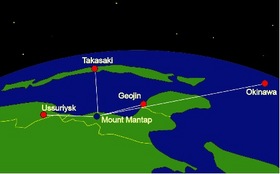 A paper in the current issue of the journal Science & Global Security offers potentially important new evidence suggesting that North Korea may have carried out a nuclear weapon test in May 2010. This would be the third nuclear test by North Korea and has not been previously reported. The analysis suggests that the technical and analytical basis to detect small nuclear tests using radionuclide signatures may be much further advanced than previously assumed.
A paper in the current issue of the journal Science & Global Security offers potentially important new evidence suggesting that North Korea may have carried out a nuclear weapon test in May 2010. This would be the third nuclear test by North Korea and has not been previously reported. The analysis suggests that the technical and analytical basis to detect small nuclear tests using radionuclide signatures may be much further advanced than previously assumed.
The paper, Radionuclide Evidence for Low-Yield Nuclear Testing in North Korea in April/May 2010, is authored by Lars-Erik De Geer, Research Director at the Swedish Defence Research Agency, Stockholm. He has worked for over four decades on the atmospheric transport and detection of radioactive particles and gases of the kind released by nuclear explosions.
The paper is available for free download at the Taylor & Francis web site.
The paper presents an analysis of radionuclide data collected between 14 and 23 May 2010 at stations in South Korea, Japan and Russia to suggest that North Korea carried out a very low-yield underground nuclear test on 11 May 2010. It reconstructs the initial radionuclide release from the possible explosion using the characteristics of the radionuclide detector and atmospheric modeling software. The analysis also supports another possible test in mid-April 2010, but with considerably less evidence.
The paper concludes that the May 2010 North Korean nuclear test may have had a yield of less than 50 tons of TNT equivalent (and possibly up to 200 tons of TNT equivalent if the explosion was partially decoupled from the surrounding rock). A yield in this range is consistent with the fact that no seismic signals associated with such a test have been detected.
This estimate of the yield suggests that the test was significantly smaller than the two previous North Korean tests, conducted in 2006 and 2009. These earlier tests are estimated to have had yields of 900 tons and 4600 tons of TNT equivalent respectively, and were detected seismically, and also by a radionuclide signature in the case of the 2006 test.
The analysis of the radionuclide data presented in the paper raises the possibility that the May 2010 nuclear test may have used highly enriched uranium (HEU) rather than plutonium as the key nuclear weapon material. In November 2010, North Korea revealed to visiting US experts an extensive uranium enrichment program. The existence of this uranium enrichment program has been suspected by the United States at least since 2002.
While the details of the testing scenario presented in the paper are necessarily speculative, its basic conclusion suggests that the overall capabilities for verification of the Comprehensive Test Ban Treaty (CTBT) may be much further advanced than previously assumed.
Contact the author:
Lars-Erik De Geer
Swedish Defence Research Agency
Email: ledg@foi.se
Contact the editors:
Email: editors@scienceandglobalsecurity.org
